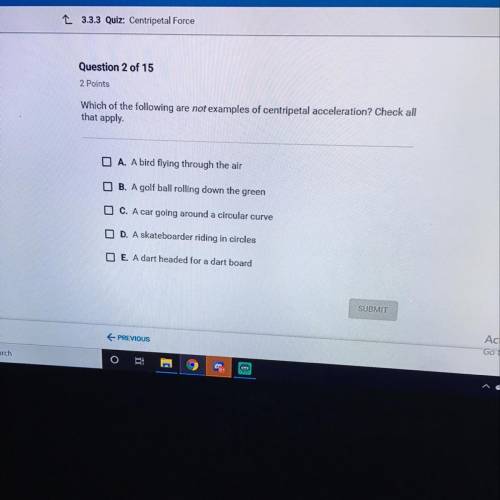that apply.

Biology, 23.05.2020 09:00 yairreyes01
Which of the following are not examples of centripetal acceleration? Check all
that apply.
O A. A bird flying through the air
O B. A golf ball rolling down the green
C. A car going around a circular curve
OD. A skateboarder riding in circles
O E. A dart headed for a dart board


Answers: 1


Another question on Biology

Biology, 21.06.2019 20:00
With the description of the different cell walls, membranes, and associated proteins set in the students' minds, you now need to introduce them to the idea that the cell wall can also act as a foundation to build things upon. bacterial appendages require a strong foundation that will offer the support needed to move and function in a dynamic world. for example, flagella are long, whiplike protein structures that are used by many gram-positive and gram-negative bacteria for locomotion. in order to function effectively, a flagellum must be firmly anchored to the cell wall. how will you be able to get across the idea that the peptidoglycan cell wall is strong enough to support such a mechanism? with a protein rod that passes through the cell wall and protein rings used to anchor it in the membranes, these basal bodies are the rudimentary biological motors that use atp power to spin the hook and the flagella attached to it. bacterial flagella have a biological motor that spins within the cell wall and is powered by atp. this allows the flagella to spin in a whiplike motion to propel the bacterium.
Answers: 3

Biology, 21.06.2019 21:30
Out of the seven main animal groups (fish, mammals, birds, insects, reptiles, amphibians, and arachnids), how many contain members with internal backbones? a. 5 b. 3 c. 7 d. 1
Answers: 1

Biology, 21.06.2019 21:30
This is one form of rna that transports a specific amino acid to a ribosome during protein synthesis.
Answers: 1

Biology, 22.06.2019 01:30
Scenario 5 1) take 10 red and 10 black beans and place them, mixed, on the table. record the starting phenotype # and frequencies (% of your total population) of your starting population in the table provided (generation 0). 2) act as a predator. “capture” as many organisms as you can until you have reduced the population to three organisms. put them aside. at this point, the predators die. 3) the remaining organisms each produce 2 clonal offspring. multiply your organisms accordingly and allow them to mix on the table. calculate and record the resultant phenotype # and frequencies (% of your total population) of your population in the table provided (generation 1). 4) repeat the reproduction event, allowing each of your organisms to produce 2 clonal offspring. calculate and record the resultant phenotype # and frequencies (% of your total population) of your population in the table provided (generation 2). 5) repeat the reproduction event, allowing each of your organisms to produce 2 clonal offspring. calculate and record the resultant phenotype # and frequencies (% of your total population) of your population in the table provided (generation 3).
Answers: 1
You know the right answer?
Which of the following are not examples of centripetal acceleration? Check all
that apply.
that apply.
Questions

History, 10.07.2019 22:30

Mathematics, 10.07.2019 22:30

Biology, 10.07.2019 22:30

Geography, 10.07.2019 22:30

Physics, 10.07.2019 22:30

Mathematics, 10.07.2019 22:30

Mathematics, 10.07.2019 22:30



Mathematics, 10.07.2019 22:30




English, 10.07.2019 22:30

Mathematics, 10.07.2019 22:30







